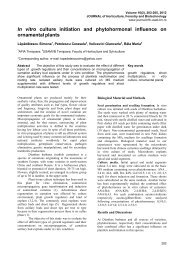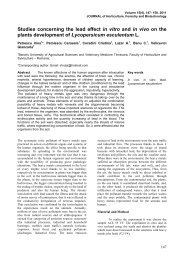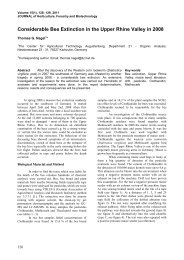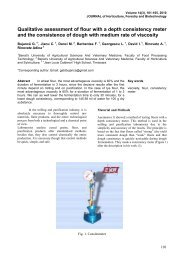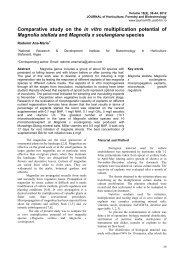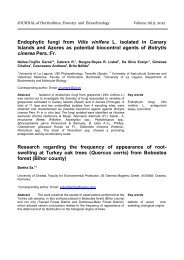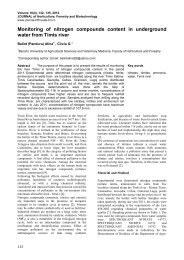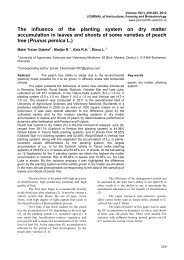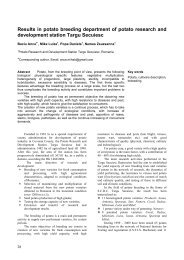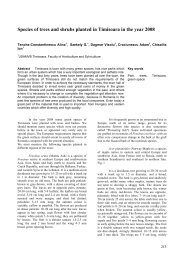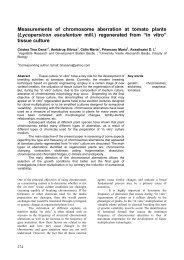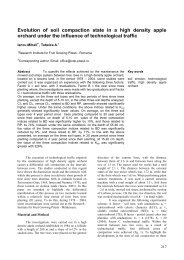Production of virus free potato plantlets - Journal of Horticulture ...
Production of virus free potato plantlets - Journal of Horticulture ...
Production of virus free potato plantlets - Journal of Horticulture ...
Create successful ePaper yourself
Turn your PDF publications into a flip-book with our unique Google optimized e-Paper software.
Volume 16(1), 232-238, 2012<br />
JOURNAL <strong>of</strong> <strong>Horticulture</strong>, Forestry and Biotechnology<br />
www.journal-hfb.usab-tm.ro<br />
<strong>Production</strong> <strong>of</strong> <strong>virus</strong> <strong>free</strong> <strong>potato</strong> <strong>plantlets</strong><br />
Danci M., 1* Danci Oana 1 , Mike Luiza 2 , Baciu Anca 2 , Olaru Daniela 1 , Petolescu Cerasela 1 ,<br />
Berbentea F. 1 , David I. 1<br />
1 Banat’s University <strong>of</strong> Agricultural Sciences and Veterinary Medicine Timişoara; 2 Potato Research and<br />
Development Station – Targu Secuiesc, Romania<br />
*Corresponding author. Email: marcel_research@yahoo.com<br />
Abstract Potatoes a high susceptibility to viral, bacterial and fungal<br />
diseases impose production <strong>of</strong> <strong>virus</strong> <strong>free</strong> material for healthy seed production<br />
since plant <strong>virus</strong>es are pathogens that cannot be destroyed by using plant<br />
protection chemicals. Meristem tip culture technique is one <strong>of</strong> the most used<br />
for <strong>potato</strong> in vitro culture initiation and is most <strong>of</strong> all used in order to obtain<br />
<strong>virus</strong> <strong>free</strong> <strong>plantlets</strong>. For this study six new Romanian <strong>potato</strong> cultivars were<br />
used. Explants were prepared for tissue culture and half <strong>of</strong> them underwent<br />
chemical (using the antiviral chemical-ribavirin) treatement. Culture tubes<br />
were incubated at 20-21 o C in 16 hr photoperiod with 2000 lux light intensity<br />
for 6-8 weeks. Leaf samples <strong>of</strong> 10 <strong>plantlets</strong> <strong>of</strong> each cultivar were tested for<br />
<strong>virus</strong>es: PVS, PVY, PVX and PLRV by ELISA technique. Virus-<strong>free</strong><br />
individuals were measured for several biometrical parameters and<br />
subcultured on fresh multiplication media for 4 weeks. Best <strong>virus</strong> <strong>free</strong><br />
production was obtained after Ribavirin treatment even if regeneration<br />
capacity after chemical therapy decreased with around 10%.<br />
Potato is one <strong>of</strong> the most important food crops<br />
in the world and especially in our country. In<br />
Romania, after wheat, <strong>potato</strong> is the second most<br />
important food crop being very important for<br />
alimentary and chemical industry and also in animal<br />
feat, due to its richness in vitamins (especially vitamin<br />
C), hydrocabonates, and starch (). It is used in<br />
alimentary industry, alcohol production and animal<br />
feeding. Potato can be propagated sexually (by<br />
botanical seed, also called true <strong>potato</strong> seed) and<br />
asexually (vegetatively) by means <strong>of</strong> tubers (Otroshy,<br />
2006). Propagation by tubers is a conventional system<br />
used by farmers. There are two major problems<br />
associated with vegetatively clonal multiplication <strong>of</strong><br />
<strong>potato</strong>-seed stocks. Firstly, low multiplication rate in<br />
the field takes as long as 7 to 12 years, causing a lack<br />
<strong>of</strong> flexibility to the changing needs <strong>of</strong> the end-users.<br />
Secondly, <strong>potato</strong>es present a high susceptibility to<br />
viral, bacterial and fungal diseases (Loebenstein et al.<br />
2001). Plant <strong>virus</strong>es are pathogens that cannot be<br />
destroyed by using plant protection chemicals. The use<br />
<strong>of</strong> <strong>virus</strong>-resistant varieties (or eradicated disease-<strong>free</strong><br />
initial seed production material) is preferred for<br />
avoiding crop yield or quality losses. Nowadays,<br />
micropropagation is the alternative to conventional<br />
propagation <strong>of</strong> <strong>potato</strong>es (Danci et al., 2011), being used<br />
as standard methodology for production <strong>of</strong> disease <strong>free</strong><br />
(<strong>virus</strong> <strong>free</strong>) seed <strong>potato</strong>es without or with<br />
chemotherapy (Faccioli and Z<strong>of</strong>foli , 1998). It is<br />
known that meristem culture is the only way to obtain<br />
<strong>virus</strong> <strong>free</strong> biological material (Loebenstein et al. 2001).<br />
Meristem tip culture was first used to produce <strong>virus</strong>-<br />
232<br />
Key words<br />
meristem tip culture, <strong>virus</strong><strong>free</strong><br />
<strong>plantlets</strong> regeneration,<br />
<strong>virus</strong> indexing, Solanum<br />
tuberosum L., Ribavirin<br />
<strong>free</strong> plants (Huang and Murashige, 1976) since<br />
meristem is domes <strong>of</strong> actively dividing cells, located at<br />
the apices <strong>of</strong> shoots and roots, that remain in an active<br />
state <strong>of</strong> division throughout the vegetative phase <strong>of</strong> the<br />
plant, forming new tissues and organs (shoots, leaves,<br />
roots); they have therefore the capability <strong>of</strong> producing<br />
complete plants in vivo and in vitro (Danci, 2007). This<br />
totipotency is the basis <strong>of</strong> the meristem tip culture<br />
technique. Virus particles, which may be present in the<br />
vascular system, can reach the meristematic region <strong>of</strong><br />
the apex only through cell to cell movement<br />
(Carrington et al, 1996); a slow process that might take<br />
within a few days (Hull, 2002). This is one <strong>of</strong> the main<br />
reasons why in a <strong>virus</strong> infected plant, <strong>virus</strong><br />
concentration decreases acropetally toward the<br />
meristem <strong>of</strong> both the apical and the axillary buds<br />
(Lizarrago et al. 1991), on assumption that <strong>virus</strong>es<br />
were unable to invade the meristematic tissues <strong>of</strong> the<br />
bud.. The in vitro technology combined with traditional<br />
methods can increased the commercial production <strong>of</strong><br />
<strong>virus</strong>-<strong>free</strong> seeds an important pre-requisite to maximize<br />
yield in <strong>potato</strong>. Potato is also the first major food crop<br />
where biotechnology has been successfully applied for<br />
<strong>virus</strong> elimination (Bajaj and Sopory, 1986). Literature<br />
reports showed that root tips <strong>of</strong> plants infected with<br />
one <strong>of</strong> several <strong>virus</strong>es have been found to be <strong>free</strong> <strong>of</strong><br />
detectable <strong>virus</strong> (Appiano and D’Agostino, 1983).<br />
Smith and Schlegel (1964) studied the distribution <strong>of</strong><br />
Clover yellow mosaic <strong>virus</strong> in root tip <strong>of</strong> Vicia faba and<br />
found that within the limit <strong>of</strong> the assay method, the<br />
first 0.4 mm <strong>of</strong> the root tip, which included the root cap<br />
and the meristem, were <strong>virus</strong> <strong>free</strong>. Thus, the optimum
size <strong>of</strong> meristem is ranging from 0.2 to 1 mm<br />
(meristematic dome without or with few leaves<br />
primordia) (Kong-Xiangsheng, 1998, Loebenstein et<br />
al. 2001, Danci et al., 2011). The larger the size <strong>of</strong> the<br />
meristem cultured, the greater is the number <strong>of</strong><br />
regenerated plant produced, thus the survival rate for<br />
<strong>potato</strong> meristems without leaf primordia is very low<br />
(Danci et al, 2011). The control <strong>of</strong> <strong>virus</strong>es, which<br />
cannot be sufficiently controlled by any physical or<br />
chemical agent, is demanded for successful production<br />
<strong>of</strong> <strong>potato</strong>es for nutritional and seed purposes. Potato<br />
Research Institute Tg. Secuiesc is one <strong>of</strong> the most<br />
important <strong>potato</strong> seed producer in Romania, creating<br />
high productive <strong>potato</strong> cultivars, but viral and bacterial<br />
infection <strong>of</strong> the clonal material determine great loss in<br />
healthy seed production and this study was conducted<br />
to standardize protocol for regeneration <strong>of</strong> the<br />
meristem, develop <strong>virus</strong>-<strong>free</strong> plants for commercial<br />
multiplication and detect the effect <strong>of</strong> <strong>virus</strong>es PVX,<br />
PVY, PVA and PLRV, by Enzyme Linked<br />
Immunosorbent assay (ELISA) technique.<br />
Biological Material and Method<br />
The research work was envisaged at In Vitro Culture<br />
and Genetic Engineering Laboratory, U.S.A.M.V.B,<br />
Timisoara, Romania and six important alimentary and<br />
agronomical Romanian <strong>potato</strong> cultivars were used as<br />
explant donors, to establish the best regeneration<br />
protocol from meristem tip explants. The <strong>potato</strong><br />
cultivars were provided by Potato Research Institute<br />
Tg. Secuiesc. Potato cultivars were planted in pots<br />
containing fine heat sterilized sand under greenhouse<br />
conditions. When <strong>potato</strong> plants grew sufficiently, the<br />
apical buds were harvested and meristems excised and<br />
in vitro cultured and the plants were kept in greenhouse<br />
conditions with the aim to grow lateral buds and<br />
produce more branches, especially for the cultivars<br />
Luiza and Armonia that presented high fungal and<br />
bacterial infections. Meristems isolated from tuber<br />
sprouts were sterilized by immersion for several<br />
seconds in 70% ethanol followed by immersion in<br />
mercuric chloride 0.1% for 2 minutes and rinsed 3<br />
times with sterile, distilled water. The tip and subtending<br />
leaf primordia were removed with in aseptic<br />
condition and inoculated half onto the <strong>virus</strong> reduction<br />
medium and half on normal regeneration culture<br />
media, in Petri dishes. The <strong>virus</strong> reduction medium<br />
contained Ribavirin or Virazole (1-β D-rib<strong>of</strong>uranosyl-<br />
1, 2, 4-triazole-3-carboxamide), the synthetic analogue<br />
<strong>of</strong> guanosine, specifically developed as an antiviral<br />
chemical (Streeter et al. 1973). The regeneration<br />
medium consisted <strong>of</strong>: Murashige and Skoog (1962) (M<br />
& S) salts, NaH2PO4.2H2O (221 mg/l), thiamine HC1<br />
(0.4 mg/l), inositol (100 mg/l), sucrose (30 g/l), agar<br />
(7.5 g/l), pH adjusted to 5.8. Culture tubes were then<br />
incubated at 20-21 o C in 16 hr photoperiod with 2000<br />
lux intensity. Plantlets regenerated were multiplied<br />
through stem cuttings on MS basal medium in culture<br />
tubes, containing indole-3-acetic acid (1mg/l), indole-<br />
3-butyric acid (1mg/l) and gibberellic acid (0.3 mg/l).<br />
After 6-8 weeks with daily, visual checks for fungal<br />
and bacterial contamination, leaf samples <strong>of</strong> 10<br />
<strong>plantlets</strong> <strong>of</strong> each cultivar were tested for <strong>virus</strong>es, PVS:<br />
Potato <strong>virus</strong> S, PVY: Potato <strong>virus</strong> Y, PVX: Potato<br />
<strong>virus</strong> X, PLRV: Potato leaf roll <strong>virus</strong> by ELISA<br />
technique using ELISA test kits PathoScreen from<br />
Agdia Inc., IN, USA. The optical density (OD) 405 nm<br />
was read after 1 h at room temperature. Duplicate wells<br />
<strong>of</strong> each sample were used along with six negative<br />
controls and two positive controls from the kit, per<br />
plate. A positive reaction was recorded when the mean<br />
OD was greater than the mean <strong>of</strong> six negative <strong>potato</strong><br />
controls plus 3 times their standard deviation. Virus<strong>free</strong><br />
individuals were measured for several biometrical<br />
parameters and subcultured on fresh media with<br />
indole-3-acetic acid (0,1mg/l), gibberellic acid<br />
(0,1mg/l) and 6-benzylaminopurine (1,5mg/l) (Danci et<br />
al., 2008) for 4 weeks and new biometrical<br />
measurements were realized.<br />
Results and Discussions<br />
The use <strong>of</strong> Ribavirin, in the culture medium<br />
has reduced the amount <strong>of</strong> <strong>virus</strong> in the regenerated<br />
<strong>plantlets</strong>. The concentration <strong>of</strong> 35 mg/l was used after<br />
experimenting (Danci et al, 2009) with a range <strong>of</strong><br />
concentrations: 10, 15, 20, 25, 30, 35, 40, 45, 50 mg/<br />
liter, when four <strong>potato</strong> genotypes were tested.<br />
Ribavirin at the highest concentrations, more than 35<br />
mg/l proved to be phytotoxic, but there was no<br />
mortality with lower concentrations and there was a<br />
good <strong>virus</strong> reduction using 35 mg/liter. Experimental<br />
results <strong>of</strong> assays are summarized in Table 1.<br />
Presence <strong>of</strong> strain <strong>virus</strong>es in <strong>potato</strong> cultivar tested before and after in vitro culture (8 weeks)<br />
Cultivar Virus type present in the tissues<br />
Before MC After MC with Rb After MC without Rb<br />
Armonia PLRV, PVX, PVS and PVY PVX in 1 <strong>of</strong> 10 cases PVX in 3<strong>of</strong> 10 cases<br />
Linia 1161 PLRV, PVX and PVS PVX and PVS in 1 <strong>of</strong> 10 cases PVX and PVS in 4 <strong>of</strong> 10 cases<br />
Luiza PLRV, PVX, PVS and PVY PVX in 2 <strong>of</strong> 10 cases PVX in 5 <strong>of</strong> 10 cases;<br />
Productiv PVX and PVY - PVX in 1 <strong>of</strong> 10 cases;<br />
Redsec PVX, PVS and PVY - PVX in 1 <strong>of</strong> 10 cases; PVX and<br />
PVS in 1 <strong>of</strong> 10 cases<br />
Speranta PLRV, PVX and PVY PVX in 1 <strong>of</strong> 10 cases PVX in 1 <strong>of</strong> 10 cases; PVX and<br />
PVY in 3 <strong>of</strong> 10 cases<br />
MC = meristem culture<br />
Table 1<br />
233
Rb = Ribavirin<br />
- = no <strong>virus</strong> presence detected<br />
Different concentrations and almost different<br />
results were obtained <strong>of</strong> other researchers due to the<br />
fact that in vitro culture response is genotype<br />
dependent as the <strong>virus</strong> eradication or <strong>virus</strong> infection is<br />
also genotype dependent. Beside Ribavirin, DHT is<br />
another chemical effective in <strong>virus</strong> eradication from<br />
<strong>potato</strong> tissues (Faccioli, 2001) and good results were<br />
obtained when it was used together with Ribavirin<br />
(Loebenstein et al., 2001) in PVM and PVS<br />
eradication. The most difficult <strong>virus</strong> to eradicate is<br />
PVX (Loebenstein et al., 2001), which due to its small<br />
234<br />
sizes can traffic cell to cell even through branched<br />
plasmodesmata to the meristemal cells (Hull, 2002)<br />
and was found even in the meristemal tip in the stem<br />
cells (Hsu et al, 2000; Hull, 2002). If mixed infection<br />
occurs, obtaining <strong>virus</strong> <strong>free</strong> plants becomes more<br />
difficult. In presence <strong>of</strong> PVY the Potato <strong>virus</strong> X<br />
becomes more aggressive and can traffic till the apical<br />
meristems, but chemotherapy and in some cases<br />
thermotherapy was useful to eradicate it (Faccioli,<br />
2001, Loebenstein et al., 2001).<br />
Regeneration rate from meristems culture with and without Ribavirin<br />
Armonia Linia 1161 Luiza Productiv Redsec Speranta<br />
x s x s x s x s x s x s<br />
x<br />
x<br />
RCM 34,37+ 0,53a 57,01+ 0,51a 33,33+ 1,33a 64,31+ 0,96a 96,22+ 2,77a 79,23+ 1,17a<br />
RCM+Rb 24,09+ 2,19b 52,30+ 1,98b 30,03+ 1,03b 63,41+ 2,57a 95,58+ 0,12a 79,08+ 2,75a<br />
x<br />
x<br />
x<br />
x<br />
Table 2<br />
Means followed by similar letters in each column are not significantly different at 5% level according to protected<br />
Fisher LSD .<br />
RCM = regeneration rate from meristems culture without Ribavirin<br />
RCM-rb= regeneration rate from meristems culture with Ribavirin<br />
Virus-<strong>free</strong> rate depends very significantly from that<br />
meristem size on regeneration, the highest percentage<br />
<strong>of</strong> plants <strong>free</strong> <strong>of</strong> <strong>virus</strong>es were obtained from meristems<br />
with the smallest size <strong>of</strong> which were <strong>free</strong> <strong>of</strong> <strong>virus</strong>es and<br />
regenerated plants without applying thermotherapy or<br />
chemotherapy (Danci O et al., 2011). This might be<br />
due to <strong>virus</strong>es lack in the meristematic dome, because<br />
this type <strong>of</strong> tissue is invaded by <strong>virus</strong>es difficult. At<br />
this level there are no plasmodesmata formed (Hull,<br />
2002) to allow <strong>virus</strong> traffic and the high<br />
concentrations <strong>of</strong> plant hormones might inhibit <strong>virus</strong><br />
replication or perhaps the high rate <strong>of</strong> multiplication<br />
cells that exceeds the rate <strong>of</strong> multiplication <strong>of</strong> the <strong>virus</strong><br />
(Loebenstein et al., 2001)<br />
Meristems regenerative capacity, meristems<br />
viability and also the percentage <strong>of</strong> <strong>virus</strong>-<strong>free</strong><br />
regenerated <strong>plantlets</strong> depend beside the meristem size<br />
(Danci et al., 2011), on the donor genotype (table 2).<br />
Best regeneration capacity was proven, indifferent <strong>of</strong><br />
the presence or absence <strong>of</strong> Ribavirin, by the cultivar<br />
Redsec; only 3.88-4.42 percentages <strong>of</strong> meristems<br />
presented necrosis and did not generate shoots,<br />
bacterial or fungal infection was present in a single<br />
culture tube. At the opposite pole the cultivars<br />
Armonia and Luiza presented the higher percentage <strong>of</strong><br />
fungal and bacterial infections, several reinitiating <strong>of</strong><br />
their meristem culture being needed. This might be the<br />
explanation <strong>of</strong> the low regeneration rate registered for<br />
these two cultivars, beside probably <strong>of</strong> their low<br />
capacity <strong>of</strong> regenerating in vitro.<br />
Table 3<br />
Analysis <strong>of</strong> variance for stem length (cm) as affected by treatment with Ribavirin after 7 weeks <strong>of</strong> culture<br />
Armonia Linia 1161 Luiza Productiv Redsec Speranta<br />
x<br />
s<br />
x<br />
s<br />
x<br />
x<br />
x<br />
x<br />
x<br />
x<br />
x<br />
RCM 10,68+0,09a 10,78+0,39a 8,75+1,03a 12,92+1,44a 14,56+0,29a 11,21+0,56a<br />
RCM+Rb 2,35+ 0,03b 2,42+ 0,03b 2,09+ 1,02b 2,97+ 0,82b 3,12+ 0,82b 2,55+ 0,55b<br />
Means followed by similar letters in each column are not significantly different at 5% level according to protected<br />
Fisher LSD<br />
RCM = regeneration rate from meristems culture without Ribavirin<br />
RCM+Rb= regeneration rate from meristems culture with Ribavirin<br />
The regenerated shots number, stem length, nodule<br />
number and roots number were significantly inferior<br />
for the samples infected when chemotherapy with<br />
Ribavirin was applied, comparing with the control,<br />
proving Ribavirin phytotoxic effect (tables 2-5). One<br />
s<br />
x<br />
s<br />
x<br />
s<br />
explanation can be that Ribavirin would either inhibit<br />
either decrease cellular activities probably interfering<br />
with cellular RNAs (Elia et al, 2008; Faccioli, 2001),<br />
not only with viral RNAs as proven, but with host<br />
RNAs, affecting cell cycle and cell proliferation. These<br />
x<br />
s
data represent the statistical calculations as<br />
Ribavirin effect was observed not only in the<br />
mathematical average <strong>of</strong> the results obtained from number <strong>of</strong> regenerated shoots from meristems, but in<br />
three repetitions <strong>of</strong> the experiments, the standard their stems elongation that was significantly lower,<br />
deviation, regeneration percentage and differences shoots regenerated from tissue culture with chemicals<br />
toward the control, considered in this case by RCM were almost four times shorter than the control (table<br />
without Ribavirin.<br />
3).<br />
Table 4<br />
Analysis <strong>of</strong> variance for nodule number as affected by treatment with Ribavirin after 7 weeks <strong>of</strong> culture<br />
Armonia Linia 1161 Luiza Productiv Redsec Speranta<br />
x s x s x s x s x s x s<br />
x<br />
x<br />
RCM 6,21+0,72a 6,16+1,46a 4,19+0,93a 6,40+0,14a 6,67+0,92a 5,17+0,58a<br />
RCM+Rb 2,01+0,03b 2,28+0,31b 2,40+0,14b 2,85+0,87b 2,08+0,14b 2,28+0,18b<br />
Means followed by similar letters in each column are not significantly different at 5% level according to protected<br />
Fisher LSD<br />
RCM = regeneration rate from meristems culture without Ribavirin<br />
RCM+Rb= regeneration rate from meristems culture with Ribavirin<br />
x<br />
Potato sprouts Potato isolated meristem Potato meristem culture<br />
Shoots regeneration from<br />
meristems<br />
RCM+Rb regeneration RCM regeneration<br />
Fig. 1 Protocol for <strong>potato</strong> <strong>virus</strong>-<strong>free</strong> material production<br />
Regeneration <strong>of</strong> <strong>potato</strong> sprouts from meristem<br />
culture was delayed by 6 to 8 weeks, when Ribavirin<br />
was used, due to the fact that Ribavirin may cause<br />
death <strong>of</strong> some meristems or is slowing down cellular<br />
metabolic processes (Wambugu, 1985, Faccioli, 2001,<br />
Danci et al, 2009). Whilst control meristems generated<br />
x<br />
x<br />
1 cm sprouts 10 days (in average) after inoculation,<br />
meristems inoculated on Ribavirin added media gave<br />
shots <strong>of</strong> about 1 cm long only after 22 to 40 days (fig<br />
1). The nodule number, statistically correlated with<br />
stem length, was significantly lower in the cultures<br />
added with Ribavirin, from 2 to 3 times (table 4).<br />
Table 5<br />
Analysis <strong>of</strong> variance for number <strong>of</strong> roots as affected by treatment with Ribavirin after 7 weeks <strong>of</strong> culture<br />
Armonia Linia 1161 Luiza Productiv Redsec Speranta<br />
x s x s x s x s x s x s<br />
x<br />
x<br />
RCM 12,12+ 1,22a 10,89+ 0,51a 13,33+1,33a 15,07+0,46a 15,19+0,58a 14,65+0,76a<br />
RCM+Rb 1,07+0,46b 1,61+0,02b 0,00+0,00b 1,92+0,58b 1,95+0,09b 1,57+1,23b<br />
Means followed by similar letters in each column are not significantly different at 5% level according to protected<br />
Fisher LSD .<br />
RCM = regeneration rate from meristems culture without Ribavirin<br />
RCM+Rb= regeneration rate from meristems culture with Ribavirin<br />
A few development <strong>of</strong> rooting system or even lack <strong>of</strong><br />
the roots was observed on shoots regenerated after<br />
chemotherapy, comparing with normal RCM that<br />
x<br />
x<br />
x<br />
presented a number <strong>of</strong> roots more than 12 times (table<br />
5).<br />
x<br />
x<br />
235
Transferring <strong>virus</strong>-<strong>free</strong> <strong>plantlets</strong> to<br />
multiplication culture medium, without applying any<br />
chemical treatment, still showed a decreasing for all<br />
examined traits, but in some cases, no statistically<br />
236<br />
differences were registered. The effects <strong>of</strong> using<br />
Ribavirin in the regeneration medium determined<br />
different results on rooting and shooting <strong>of</strong> <strong>plantlets</strong><br />
transferred in multiplication cultures (tables 6-8).<br />
Table 6<br />
Analysis <strong>of</strong> variance for stem length (cm) in the multiplication culture medium, after 4 weeks <strong>of</strong> culture<br />
Armonia Linia 1161 Luiza Productiv Redsec Speranta<br />
x<br />
s<br />
x<br />
s<br />
x<br />
s<br />
x<br />
x<br />
x<br />
x<br />
x<br />
x<br />
RCM 7,56+ 1,89a 7,22+ 0,45a 5,43+ 0,33a 8,21+ 0,60a 9,82+ 0,27a 7,92+ 0,17a<br />
RCM+Rb 6,03+ 1,85b 5,73+ 0,98b 3,42+ 0,09b 5,02+ 0,51b 8,58+ 0,19b 6,18+ 0,61b<br />
Means followed by similar letters in each column are not significantly different at 5% level according to protected<br />
Fisher LSD .<br />
RCM = regeneration rate from meristems culture without Ribavirin<br />
RCM+Rb= regeneration rate from meristems culture with Ribavirin<br />
Stem length measured after 4 weeks <strong>of</strong> culture was still<br />
significantly reduced on the <strong>plantlets</strong> regenerated from<br />
media with Ribavirin even if multiplication media<br />
contained no Ribavirin yet. Phytotoxic effect <strong>of</strong><br />
Ribavirin was proved and its effects on regenerated<br />
plants even three years after treatment were found<br />
x<br />
s<br />
x<br />
s<br />
(Sidwell et al, 2005). In our case, newly regenerated<br />
shoots by single node multiplication culture that were<br />
selected from RCM+Rb cultures, showed 1.53-3.19 cm<br />
shorter stems than the <strong>plantlets</strong> from culture without<br />
Ribavirin (RCM) (table 6).<br />
Table 7<br />
Analysis <strong>of</strong> variance for nodule number in the multiplication culture medium, after 4 weeks <strong>of</strong> culture<br />
Armonia Linia 1161 Luiza Productiv Redsec Speranta<br />
x s x s x s x s x s x s<br />
x<br />
x<br />
RCM 4,07+ 0,24a 7,42+ 0,70a 6,52+ 0,63a 6,36+ 0,62a 6,28+ 0,62a 7,24+ 0,74a<br />
RCM+Rb 4,28+ 0,16a 7,38+ 0,88a 5,08+ 0,92a 6,44+ 0,74a 5,06+ 0,88b 6,12+ 0,76b<br />
Means followed by similar letters in each column are not significantly different at 5% level according to protected<br />
Fisher LSD .<br />
RCM = regeneration rate from meristems culture without Ribavirin<br />
RCM+Rb= regeneration rate from meristems culture with Ribavirin<br />
Although stem length <strong>of</strong> regenerated shoots from<br />
single node culture RCM+Rb, presented very<br />
significantly decreased results in the case <strong>of</strong> roots<br />
x<br />
x<br />
x<br />
number and the number <strong>of</strong> nodes per plant, were less<br />
significantly different in almost all the cases (tables 7<br />
and 8).<br />
Table 8<br />
Analysis <strong>of</strong> variance for number <strong>of</strong> roots in the multiplication culture medium, after 4 weeks <strong>of</strong> culture<br />
Armonia Linia 1161 Luiza Productiv Redsec Speranta<br />
x s x s x s x s x s x s<br />
x<br />
x<br />
RCM 9,04+0,74a 10,11+0,88a 9,17+0,00a 8,45+1,03a 8,56+1,46a 8,68+1,09a<br />
RCM+Rb 8,85+1,92a 8,78+0,39b 8,75+1,03a 8,56+1,29a 9,21+1,56b 9,17+0,00a<br />
Means followed by similar letters in each column are not significantly different at 5% level according to protected<br />
Fisher LSD .<br />
RCM = regeneration rate from meristems culture without Ribavirin<br />
RCM+Rb= regeneration rate from meristems culture with Ribavirin<br />
Ribavirin mechanism <strong>of</strong> action may be related to<br />
its ability to cause a decrease in intracellular guanosine<br />
triphosphate pools, to inhibit capping <strong>of</strong> viral<br />
transcripts or to suppress cellular immune responses.<br />
Last year, another possibility was added that when<br />
converted to the triphosphate, Ribavirin is utilized by<br />
the viral RNA-dependent RNA polymerase and causes<br />
lethal mutagenesis <strong>of</strong> the viral genome. But its toxicity<br />
will need most careful scrutiny because nucleosides are<br />
x<br />
x<br />
x<br />
likely to affect the host's DNA (Streeter et al., 1973).<br />
The inhibition <strong>of</strong> the replication <strong>of</strong> several <strong>potato</strong>es by<br />
Ribavirin was studied by Lerch (2002). The inhibition<br />
is reversed to different degrees by all ribo- and<br />
deoxyribonucleosides, most strongly by thymidine. In<br />
tobacco leaves, nucleosides compete with ribavirin for<br />
phosphorylation to monophosphate by a nucleoside<br />
phosphotransferase. However, the final and main<br />
phosphorylation product <strong>of</strong> ribavirin is triphosphate. It<br />
x<br />
s<br />
x<br />
x
is suggested that Ribavirin triphosphate is the antiviral<br />
form and that it acts by inhibiting the capping <strong>of</strong> viral<br />
RNAs. This mode <strong>of</strong> action cannot be applied to the<br />
inhibition <strong>of</strong> PVY, the RNA <strong>of</strong> which is probably<br />
covalently linked to a protein at the 5’ terminus (Lerch,<br />
2002).<br />
Ribavirin phytotoxic effect was tested on <strong>plantlets</strong><br />
<strong>of</strong> four varieties <strong>of</strong> noble canes and <strong>plantlets</strong> treated<br />
with Ribavirin at a concentration <strong>of</strong> 30 mg/l perished<br />
after three subcultures (Parmessur and Saumtally,<br />
2001). Spak et al (2010) developed a new method for<br />
testing antiviral compounds against plant <strong>virus</strong>es based<br />
on rapidly growing brassicas in vitro on liquid<br />
medium. This method enabled exchange <strong>of</strong> media<br />
containing tested chemicals in various concentrations<br />
and simultaneous evaluation <strong>of</strong> their phytotoxicity and<br />
antiviral activity. While using ribavirin as a standard<br />
for comparison, phytotoxicity and ability <strong>of</strong> the acyclic<br />
nucleotide analogues (R)-PMPA, PMEA, PMEDAP,<br />
and (S)-HPMPC to eliminate ssRNA Turnip yellow<br />
mosaic <strong>virus</strong> (TYMV) were evaluated by this method.<br />
Double antibody sandwich ELISA and real-time PCR<br />
were used for relative quantification <strong>of</strong> viral protein<br />
and nucleic acid in plants and Ribavirin had the most<br />
powerful antiviral effect against TYMV, but also the<br />
highest phytotoxic effect on brassicas explants (Spak et<br />
al, 2010). The antiviral activity <strong>of</strong> a mammalian<br />
guanosine analogue agent, Ribavirin, was evaluated in<br />
cultures <strong>of</strong> plant cells infected with tomato spotted wilt<br />
<strong>virus</strong> (TSWV) (Quencini et al., 2008). The growth<br />
kinetics <strong>of</strong> the cultured cells was analyzed by direct<br />
counting and by an indirect correlation method. TSWV<br />
infection significantly reduced the overall growth rate<br />
and increased the duration <strong>of</strong> the lag phase <strong>of</strong> cell<br />
growth. The impairment <strong>of</strong> cell growth was partially<br />
reduced by the application <strong>of</strong> Ribavirin to the plants<br />
prior to cell isolation and, as observed in mammalian<br />
systems, the effectiveness <strong>of</strong> the compound increased<br />
with time in an asymptotic manner. A slight negative<br />
effect <strong>of</strong> Ribavirin was observed in non-infected cells,<br />
suggesting that its action is not completely selective in<br />
plants (Quencini et al., 2008).<br />
References<br />
1.Carrington, J.C., Kasschau, K.D., Makajan, S.K., and<br />
Schaad, M.C., 1996, Cell-to-cell and long-distance<br />
transport <strong>of</strong> <strong>virus</strong>es in plants. Plant Cell 8, 1669-1681<br />
2.Danci M., 2007, Culturi in vitro si micropropagare,<br />
Editura Eurobit Timisoara.<br />
3.Danci O., Danci M., Berbentea F., 2008, Studies<br />
regarding <strong>potato</strong> micropropagation by single node<br />
culture, Research <strong>Journal</strong> <strong>of</strong> Agricultural Science, vol<br />
40 (3), 21-24<br />
4.Danci, O., Erdei, L., Vidacs, L., Danci, M., Baciu,<br />
A., David, I., Berbentea, F., 2009, Influence <strong>of</strong><br />
ribavirin on <strong>potato</strong> plants regeneration and <strong>virus</strong><br />
eradication. <strong>Journal</strong> <strong>of</strong> <strong>Horticulture</strong>, Forestry and<br />
Biotechnology. 13, 421–425<br />
5.Danci O., Baciu A., Danci M., 2011, Potato<br />
(Solanum tuberosum L.) regeneration using the<br />
technique <strong>of</strong> meristem tip culture, <strong>Journal</strong> <strong>of</strong><br />
<strong>Horticulture</strong>, Forestry and Biotechnology, vol 15 (4),<br />
175-178<br />
6.Elia G, Belloli C, Cirone F., 2008, In vitro efficacy <strong>of</strong><br />
ribavirin against canine distemper <strong>virus</strong>, Antiviral<br />
Research, vol 77(2), 108- 113<br />
7.Faccioli, G., Colombarini, A., 1996, Correlation <strong>of</strong><br />
<strong>potato</strong> <strong>virus</strong> S and <strong>virus</strong> M contents <strong>of</strong> <strong>potato</strong> meristem<br />
tips with the percentage <strong>of</strong> <strong>virus</strong>-<strong>free</strong> <strong>plantlets</strong><br />
produced in vitro. Potato Research, vol 39, 129-140<br />
8.Faccioli G. and Z<strong>of</strong>foli R., 1998, Fast eradication <strong>of</strong><br />
<strong>potato</strong> <strong>virus</strong> X (PVX) and <strong>potato</strong> <strong>virus</strong> S (PVS)<br />
chemotherapy, Phytopath. Medit., vol 37, 9-12<br />
9.Faccioli G., 2001, Control <strong>of</strong> <strong>potato</strong> <strong>virus</strong>es using<br />
meristem and stem-cutting cultures, Thermotheraphy<br />
and Chemotherapy. In: Loebenstein, G., et al. (eds.)<br />
Virus and Virus like Diseases <strong>of</strong> Potatoes and<br />
<strong>Production</strong> <strong>of</strong> Seed-Potatoes, 365-390.<br />
10.Hsu, Y.H., Annamalai, P., Lin, C.S., Chen, Y.Y.,<br />
Chang, W.C., Lin, N.S., 2000, A sensitive method for<br />
detecting bamboo mosaic <strong>virus</strong> (BaMV) and<br />
establishment <strong>of</strong> BaMV <strong>free</strong> meristem-tip cultures.<br />
Plant Pathology 49, 101-107<br />
11.Huang L, Murashige T., 1976, Plant tissue culture<br />
media: major constituents, their preparation and some<br />
applications. Tissue Culture Association Manual 3,<br />
539-48<br />
12.Hull R., 2002, Induction <strong>of</strong> disease: Virus<br />
movement through the plant and effect on plant<br />
metabolism, In: Matthew’s Plant Virology, Fourth<br />
Edition, 373-411.<br />
13.Kong-Xiangsheng, 1998, Studies on apical<br />
meristem culture and rapid propagation techniques for<br />
sweet <strong>potato</strong>es. Acta-Agriculturae- Universitatis-<br />
Henanensis. 2: 133-137.<br />
14. Lerch B., 2002, On the inhibition <strong>of</strong> plant <strong>virus</strong><br />
multiplication by Ribavirin, Antiviral Research,<br />
7 (5), 257-270<br />
15.Lizarraga, R., A. Panta, R. Jayasinghe, Dodds J,,<br />
1991, Tissue Culture for Elimination <strong>of</strong> Pathogens.<br />
International Potato Center, Lima, 21 (Research<br />
Guide,3)<br />
16.Loebenstein, G., Berger, P.H., Brunt, A.A., Lawson,<br />
R.H., 2001, Virus and Virus-like diseases <strong>of</strong> <strong>potato</strong>es<br />
and production <strong>of</strong> seed-<strong>potato</strong>es. Kluwer Academic<br />
Publishers. Dordrecht, Olanda<br />
17.Murashige TE, Skoog F, 1962, A revised medium<br />
for rapid growth and bioassays with tobacco tissue<br />
culture, Phy.Pl., vol 15, 431-497<br />
18.Otroshy, M., 2006, Utilization <strong>of</strong> tissue culture<br />
techniques in a seed <strong>potato</strong> tuber production scheme.<br />
Doctoral thesis, Wageningen University,Wageningen,<br />
The Netherlands.<br />
19.Parmessur Y., Saumtally A., 2001, Elimination <strong>of</strong><br />
Sugarcane yellow leaf <strong>virus</strong> and Sugarcane bacilliform<br />
<strong>virus</strong> by tissue culture. AMAS 2001. Food and<br />
237
Agricultural Research Council, Réduit, Mauritius, 127-<br />
133<br />
20.Quecini V., Lopes M.L., Pacheco F. T. H.,<br />
Ongarelli M. G., 2008, Ribavirin, a guanosine analogue<br />
mammalian antiviral agent, impairs tomato spotted wilt<br />
<strong>virus</strong> multiplicationin tobacco cell cultures, Archives<br />
Of Phytopathology And Plant Protection, vol 41 (1), 1-<br />
13<br />
21.Sidwell RW, Bailey KW, Wong MH, Barnard DL,<br />
Smee DF, 2005, In vitro and in vivo influenza <strong>virus</strong>inhibitory<br />
effects <strong>of</strong> viramidine". Antiviral Res. 68 (1),<br />
10–7<br />
22.Spak J., Holy A., Pavingerova D., Votruba I.,<br />
Spakova V., Petrzik K., 2010, New in vitro method for<br />
238<br />
evaluating antiviral activity <strong>of</strong> acyclic nucleoside<br />
phosphonates against plant <strong>virus</strong>es, Antiviral<br />
Research, 88 (3), 296-303<br />
23.Streeter, D. G.; Witkowski, J. T.; Khare, G. P.;<br />
Sidwell, R. W.; Bauer, R. J.; Robins, R. K.; Simon, L.<br />
N., 1973, Mechanism <strong>of</strong> action <strong>of</strong> 1-P-Drib<strong>of</strong>uranosyl-<br />
l,2,4-triazole-3-carboxamide (virazole), a new broad<br />
spectrum antiviral agent. Proceedings <strong>of</strong> the National<br />
Academy <strong>of</strong> Sciences,USA 70: 1174-1178<br />
24.Wambugu, F.M., 1985, Eradication <strong>of</strong> <strong>potato</strong> <strong>virus</strong><br />
Y and S from <strong>potato</strong> by chemotherapy <strong>of</strong> cultured<br />
axillary bud tips. American Potato <strong>Journal</strong> 62: 667-<br />
672.



